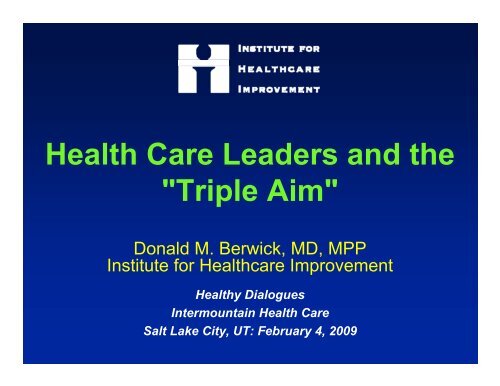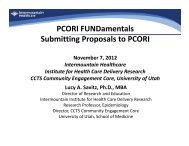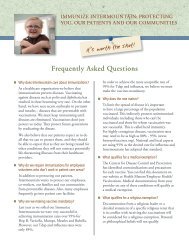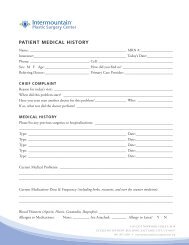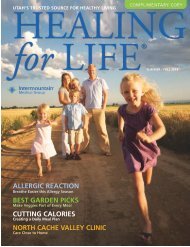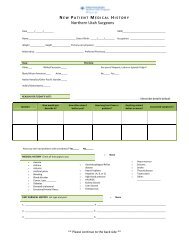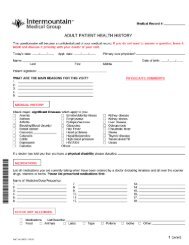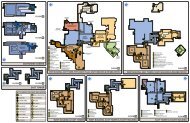Health Care Leaders and the "Triple Aim" - Intermountain Healthcare
Health Care Leaders and the "Triple Aim" - Intermountain Healthcare
Health Care Leaders and the "Triple Aim" - Intermountain Healthcare
Create successful ePaper yourself
Turn your PDF publications into a flip-book with our unique Google optimized e-Paper software.
<strong>Health</strong> <strong>Care</strong> <strong>Leaders</strong> <strong>and</strong> <strong>the</strong><br />
"<strong>Triple</strong> Aim"<br />
Donald M. Berwick, MD, MPP<br />
Institute for <strong>Health</strong>care Improvement<br />
<strong>Health</strong>y Dialogues<br />
<strong>Intermountain</strong> <strong>Health</strong> <strong>Care</strong><br />
Salt Lake City, UT: February 4, 2009
International Comparison of Spending<br />
on <strong>Health</strong>, 1980–2005<br />
Average spending on health<br />
per capita ($US PPP*)<br />
Total expenditures on health<br />
as percent of GDP<br />
2<br />
* PPP=Purchasing Power Parity.<br />
Data: OECD <strong>Health</strong> Data 2007, Version 10/2007.<br />
Source: Commonwealth Fund National Scorecard on U.S. <strong>Health</strong> System Performance, 2008
Difficulty Getting <strong>Care</strong> on Nights, Weekends, Holidays Without<br />
Going to <strong>the</strong> Emergency Room, Among Sicker Adults<br />
Percent of adults who sought care reporting “very” or “somewhat” difficult<br />
2005 2007<br />
United States<br />
International Comparison<br />
3<br />
AUS=Australia; CAN=Canada; GER=Germany; NETH=Ne<strong>the</strong>rl<strong>and</strong>s; NZ=New Zeal<strong>and</strong>; UK=United Kingdom.<br />
Data: 2005 <strong>and</strong> 2007 Commonwealth Fund International <strong>Health</strong> Policy Survey.<br />
Source: Commonwealth Fund National Scorecard on U.S. <strong>Health</strong> System Performance, 2008
Mortality Amenable to <strong>Health</strong> <strong>Care</strong><br />
Deaths per 100,000 population*<br />
4<br />
* Countries’ age-st<strong>and</strong>ardized death rates before age 75; including ischemic heart disease, diabetes, stroke, <strong>and</strong> bacterial<br />
infections.<br />
See report Appendix B for list of all conditions considered amenable to health care in <strong>the</strong> analysis.<br />
Data: E. Nolte <strong>and</strong> C. M. McKee, London School of Hygiene <strong>and</strong> Tropical Medicine analysis of World <strong>Health</strong> Organization<br />
mortality files (Nolte <strong>and</strong> McKee 2008).<br />
Source: Commonwealth Fund National Scorecard on U.S. <strong>Health</strong> System Performance, 2008
Infant Mortality Rate<br />
(Infant deaths per 1,000 live births)<br />
National Average <strong>and</strong> State Distribution International Comparison, 2004<br />
5<br />
^ Denotes baseline year.<br />
Data: National <strong>and</strong> state—National Vital Statistics System, Linked Birth <strong>and</strong> Infant Death Data (AHRQ 2003, 2004, 2005,<br />
2006, 2007a); international comparison—OECD <strong>Health</strong> Data 2007, Version 10/2007.<br />
Source: Commonwealth Fund National Scorecard on U.S. <strong>Health</strong> System Performance, 2008
Variations in Spending Across<br />
Regions (Elliott Fisher)<br />
$8,580 to $14,360 (61)<br />
$7,820 to < $8,580 (62)<br />
$7,190 to < $7,820 (60)<br />
$6,620 to < $7,190 (62)<br />
$5,280 to < $6,620 (61)<br />
Not Populated<br />
Source: The Dartmouth Atlas of <strong>Health</strong> <strong>Care</strong> 2005.
What Do Highest Quintile Cost Regions Get<br />
for an $3000 Extra per Capita per Year<br />
COSTS AND RESOURCE USE….<br />
• 32% more hospital beds per capita<br />
• 65% more medical specialists<br />
• 75% more internists<br />
• More rapidly rising per capita resource use<br />
7<br />
QUALITY AND RESULTS…<br />
• Technically worse care<br />
• No more major elective surgery<br />
• More hospital stays, visits, specialist use, tests, <strong>and</strong> procedures<br />
• Slightly higher mortality<br />
• Same functional status<br />
• Worse communication among physicians<br />
• Worse continuity of care<br />
• More barriers to quality of care<br />
• Lower satisfaction with hospital care<br />
• Less access to primary care<br />
• Lower gains in survival
Scores: Dimensions of a<br />
High Performance <strong>Health</strong> System<br />
8<br />
Schoen C, Davis K, How SKH, Schoenbaum SC. US health system performance: A national<br />
scorecard. <strong>Health</strong> Aff. 2006;25(6):w457-w475.
What Should We Aim for<br />
• No Needless Deaths<br />
• No Needless Pain or Suffering<br />
• No Unwanted Waits<br />
• No Helplessness<br />
•No Waste<br />
……For Anyone<br />
10
Aims<br />
• Safety<br />
• Effectiveness<br />
• Patient-centeredness<br />
• Timeliness<br />
• Efficiency<br />
• Equity<br />
11
Preventing Central Line Infections<br />
• H<strong>and</strong> hygiene<br />
• Maximal barrier precautions<br />
• Chlorhexidine skin antisepsis<br />
• Appropriate ca<strong>the</strong>ter site <strong>and</strong><br />
administration system care<br />
• Daily review of line necessity <strong>and</strong> prompt<br />
removal of unnecessary lines<br />
12
Central Line Associated Bloodstream Infections (CLABs)<br />
(from Rick Shannon, MD, West Penn Allegheny <strong>Health</strong> System)<br />
13
IHI’s “Rings” of Activity<br />
Innovation<br />
Prototype<br />
Dissemination<br />
14
15<br />
The “100,000 Lives Campaign”
The Campaign “Planks” --<br />
Six Changes That Save Lives<br />
1. Deployment of Rapid Response Teams<br />
2. Delivery of Reliable, Evidence-Based<br />
<strong>Care</strong> for Acute Myocardial Infarction<br />
3. Medication Reconciliation<br />
4. Prevention of Central Line Infections<br />
5. Prevention of Surgical Site Infections<br />
6. Prevention of Ventilator-Associated<br />
Pneumonias<br />
16
Rapid Response Results:<br />
Benedictine Hospital<br />
43% Reduction<br />
17
-0.3000<br />
<strong>Care</strong>Science Observed minus Expected Mortality Rate per 100 Discharges<br />
Ascension <strong>Health</strong> System<br />
-0.4000<br />
-0.5000<br />
-0.6000<br />
-0.7000<br />
-0.8000<br />
-0.9000<br />
Apr-03<br />
May-03<br />
Jun-03<br />
Jul-03<br />
Aug-03<br />
Sep-03<br />
Oct-03<br />
Nov-03<br />
Dec-03<br />
Jan-04<br />
Feb-04<br />
Mar-04<br />
Apr-04<br />
May-04<br />
Jun-04<br />
Jul-04<br />
Aug-04<br />
Sep-04<br />
Oct-04<br />
Nov-04<br />
Dec-04<br />
Jan-05<br />
Feb-05<br />
Mar-05<br />
Apr-05<br />
May-05<br />
Jun-05<br />
Jul-05<br />
Aug-05<br />
Sep-05<br />
Oct-05<br />
Nov-05<br />
Dec-05<br />
Observed minus Expected Rate per 100 Discharges<br />
18<br />
Ascension <strong>Health</strong> Mortality Reduction<br />
Baseline<br />
1,038 Mortalities<br />
Avoided (Year 2)<br />
374 Mortalities<br />
Avoided<br />
(9 mos. of Year 3)<br />
1,412 Mortalities<br />
Avoided Since<br />
Baseline Period<br />
Actual Monthly Difference p-bar (Center Line for Difference) LCL UCL
An International Movement of<br />
Movements
The Campaign “Planks” –<br />
Six Changes That Save Lives<br />
1. Deployment of Rapid Response Teams<br />
2. Delivery of Reliable, Evidence-Based<br />
<strong>Care</strong> for Acute Myocardial Infarction<br />
3. Medication Reconciliation<br />
4. Prevention of Central Line Infections<br />
5. Prevention of Surgical Site Infections<br />
6. Prevention of Ventilator-Associated<br />
Pneumonias<br />
23
Six Additional Planks<br />
7. Prevent Pressure Ulcers<br />
8. Reduce Methicillin-Resistant Staphylococcus<br />
Aureus (MRSA) Infection<br />
9. Prevent Harm from High-Alert Medications<br />
10.Reduce Surgical Complications (<strong>the</strong> Surgical<br />
<strong>Care</strong> Improvement Project (SCIP))<br />
11.Deliver Reliable, Evidence-Based <strong>Care</strong> for<br />
Congestive Heart Failure<br />
12.Get Boards on Board<br />
24
Significant Overlaps<br />
• NQF-NPP National Priorities <strong>and</strong> Goals<br />
– Engage patients <strong>and</strong> families<br />
– Improve <strong>the</strong> health of <strong>the</strong> population<br />
– Improve safety <strong>and</strong> reliability<br />
– Ensure patients receive well-coordinated care<br />
– Guarantee appropriate <strong>and</strong> compassionate end-of-life care<br />
– Eliminate overuse<br />
• CMS – QIO 9 th Scope of Work<br />
─ Pressure Ulcers<br />
─ MRSA<br />
─ SCIP<br />
─ Drug Safety<br />
─ Challenged providers…
Medicare “No Pay” Hazards<br />
• Object left in patient during surgery<br />
• Air embolism<br />
• Blood incompatibility<br />
• Ca<strong>the</strong>ter-associated urinary tract infections<br />
• Vascular-ca<strong>the</strong>ter-associated infections<br />
• Pressure ulcers<br />
• Mediastinitis after coronary-artery bypass<br />
grafting<br />
• Falls from bed
What is Possible<br />
• 150 New Jersey organizations reduced pressure ulcers<br />
by 70%<br />
• More than 65 Campaign hospitals report going more<br />
than a year without a ventilator-associated pneumonia<br />
• More than 35 report going a year without a central line<br />
infection<br />
• Looking elsewhere…Drops in adverse event rates of<br />
51%-75% in four Safer Patients Initiative hospitals
What is Possible<br />
It’s no longer possible to say it’s not<br />
possible…<br />
…<strong>and</strong> that’s our first job.
Does Improving Safety Save Money<br />
SERIOUS PREVENTABLE INFECTIONS<br />
(“PURPLE BUGS”)<br />
BUG<br />
CASES<br />
PER YR<br />
DEATHS<br />
PER YR<br />
LOS<br />
COST PER<br />
CASE<br />
MRSA 126,000 5,000 +9.1 DAYS +$32,000<br />
C.<br />
DIFFICILE<br />
211,000 6,000 + 3 DAYS +$3,500<br />
VRE 21,000 1,000 +$12,700<br />
TOTAL<br />
COST<br />
+$4<br />
BILLION<br />
+$1<br />
BILLION<br />
+$268<br />
MILLION<br />
MRSA, C. difficile, <strong>and</strong> VRE combined annually infect<br />
at least 350,000 people, cause at least 12,000<br />
deaths, <strong>and</strong> increase care costs by at least $5 billion<br />
29
Does Improving Safety Save Money<br />
HENRY FORD HEALTH SYSTEM<br />
IMPROVEMENT COST SAVINGS NET<br />
SURGICAL<br />
INFECTIONS<br />
BLOODSTREAM<br />
INFECTIONS<br />
VENTILATOR<br />
PNEUMONIAS<br />
RAPID RESPONSE<br />
TEAMS<br />
($110,000) $540,000 $430,000<br />
($22,500) $4,780,000 $4,757,500<br />
($1,268,500)<br />
(Reduced Revenue)<br />
$1,166,400 ($102,100)<br />
($390,000) ($390,000)<br />
TOTAL ($1,791,000) $5,320,000 $4,695,400<br />
30
Drivers of a Low-Value System<br />
Low Value<br />
High Cost<br />
Low Quality<br />
New Drugs<br />
<strong>and</strong> Tech ≠<br />
Outcomes<br />
No<br />
Mechanism<br />
to Control<br />
Cost at <strong>the</strong><br />
Population<br />
Level<br />
Supply-<br />
Driven<br />
Dem<strong>and</strong><br />
Over-<br />
Reliance<br />
on Doctors<br />
No Foreign<br />
Competition<br />
Under-<br />
Valuing<br />
System<br />
Knowledge<br />
31
<strong>Health</strong> <strong>Care</strong> Costs Are Concentrated in Sick Few—<br />
The Sickest 10% Account for 64% of Expenses<br />
Distribution of <strong>Health</strong> Expenditures for <strong>the</strong> U.S. Population,<br />
by Magnitude of Expenditure, 2003<br />
1%<br />
5%<br />
10%<br />
24%<br />
Expenditure<br />
Threshold<br />
(2003 dollars)<br />
$36,280<br />
50%<br />
49%<br />
64%<br />
$12,046<br />
$6,992<br />
97%<br />
$715<br />
32<br />
Zuvekas SH, Cohen JW. Prescription drugs <strong>and</strong> <strong>the</strong> changing concentration of health care expenditures.<br />
<strong>Health</strong> Aff. 2007;26(1):249–257.
Proven<strong>Care</strong> SM :<br />
Coronary Artery Bypass<br />
A Provider-Driven, Acute Episodic <strong>Care</strong><br />
“Pay-for-Performance” Initiative:<br />
29
A Case Study at Geisinger<br />
Improve Cardiovascular Surgery<br />
Anaes<strong>the</strong>sia<br />
Technical<br />
Surgery<br />
Medication<br />
Use<br />
Medications<br />
SSI<br />
Prophylaxis<br />
Teamwork<br />
Sedatives<br />
Myocardial<br />
Protection<br />
Ventilator<br />
Management<br />
Supplies<br />
Blood<br />
Products<br />
34
Proven<strong>Care</strong> TM :Coronary Artery Bypass<br />
Go Live<br />
Hired performance improvement clinician<br />
% of<br />
patients who<br />
receive all<br />
components<br />
of care<br />
Documented current processes<br />
Engaged remaining stakeholders<br />
Confirmed<br />
“Proven<strong>Care</strong> CABG”<br />
processes &<br />
accountabilities<br />
35
Improving a Population-Based System<br />
Preserve Myocardial <strong>Health</strong><br />
in <strong>the</strong> Population<br />
Tier 1:<br />
Big Dot<br />
Improve<br />
Ischemia<br />
Outcomes<br />
Reduce Adult<br />
Risk Factors<br />
Change<br />
Childhood<br />
Behaviors<br />
Tier 2:<br />
Portfolio<br />
Tier 3:<br />
Projects<br />
36
The “<strong>Triple</strong> Aim”<br />
Population<br />
<strong>Health</strong><br />
Experience<br />
of <strong>Care</strong><br />
Per Capita<br />
Cost<br />
37
A New Improvement Agenda<br />
That Matches <strong>the</strong> Societal Need<br />
<strong>Care</strong><br />
Now<br />
Population<br />
<strong>Health</strong><br />
Experience<br />
of <strong>Care</strong><br />
Per Capita<br />
Cost<br />
38
The “<strong>Triple</strong> Aim”<br />
• Improve Individual Experience<br />
• Improve Population <strong>Health</strong><br />
• Control Inflation of Per Capita Costs<br />
The root of <strong>the</strong> problem in health care is that <strong>the</strong> business<br />
models of almost all US health care organizations depend on<br />
keeping <strong>the</strong>se three aims separate. Society on <strong>the</strong> o<strong>the</strong>r h<strong>and</strong><br />
needs <strong>the</strong>se three aims optimized (given appropriate<br />
weightings on <strong>the</strong> components) simultaneously.<br />
--- (Tom Nolan, PhD)<br />
39
Some System Components to<br />
Accomplish <strong>the</strong> <strong>Triple</strong> Aim<br />
• Focus on Individuals <strong>and</strong> Families<br />
• Strong “Primary <strong>Care</strong>” Services <strong>and</strong><br />
Structures<br />
• Population <strong>Health</strong> Management<br />
• Cost Control Platform<br />
• System Integration<br />
AND an “Integrator”<br />
40
The “Integrator’s” Tasks<br />
• Design:<br />
– <strong>Care</strong> <strong>and</strong> Finance Models<br />
– Ways to Engage <strong>the</strong> Population<br />
• Establish Essential Business Relationships:<br />
– Specialty <strong>Care</strong> <strong>and</strong> High-Tech <strong>Care</strong><br />
– Community-Based Services<br />
• Measure Performance in New Ways:<br />
– Track People over Time<br />
– Measure Costs<br />
• Test <strong>and</strong> Analyze to Learn What Works<br />
– A Learning Community<br />
– Managed Experiments<br />
• Develop <strong>and</strong> Deploy Information Technology<br />
– To Integrate Across Boundaries<br />
41<br />
– To Give Patients Knowledge <strong>and</strong> Control
Current <strong>Triple</strong> Aim Sites<br />
• Hospital-Based Systems<br />
Cape Fear Valley (NC)<br />
Bellin <strong>Health</strong> (WI)*<br />
Cincinnati Children’s Hospital Medical Center (OH)*<br />
Genesys <strong>Health</strong> (MI) (Ascension)*<br />
Theda<strong>Care</strong> (WI)<br />
• <strong>Health</strong> Plans<br />
Blue Cross Blue Shield of Michigan (MI)<br />
<strong>Care</strong>Oregon (OR)*<br />
Eastern Carolina Community Plan (NC)<br />
New York-Presbyterian System Select<strong>Health</strong>, LLC (NY)*<br />
UPMC <strong>Health</strong> Plan (PA)<br />
Independent <strong>Health</strong> (NY)<br />
Wellmark (IA)<br />
• Integrated <strong>Health</strong> Systems<br />
Group <strong>Health</strong> (WA)*<br />
<strong>Health</strong>Partners (MN)*<br />
Kaiser Permanente, Colorado Region (CO)<br />
Kaiser Permanente, Mid-Atlantic Region (MD)<br />
Martin’s Point <strong>Health</strong> <strong>Care</strong> (ME)<br />
Presbyterian <strong>Health</strong>care (NM)<br />
Southcentral Foundation <strong>and</strong> Alaska Native Medical Center<br />
(AK)<br />
Veterans <strong>Health</strong> System:<br />
‣ VISN 10—Cincinnati VAMC (OH)<br />
‣ VISN 20—Portl<strong>and</strong> VAMC (OR)<br />
‣ VISN 23—Nebraska, Western Iowa VAMC (NE)<br />
• Public <strong>Health</strong> Department<br />
King County Department of Public <strong>Health</strong> (WA)<br />
• State Initiative<br />
Vermont Blueprint for <strong>Health</strong> (VT)*<br />
• Safety Net<br />
Colorado Access (CO)<br />
Contra Costa <strong>Health</strong> Services (CA)*<br />
North Colorado <strong>Health</strong> Alliance (CO)*<br />
Primary <strong>Care</strong> Coalition Montgomery County (MD)*<br />
Queens <strong>Health</strong> Network (NY)*<br />
• Employers/Businesses<br />
QuadGraphics/QuadMed (WI)*<br />
• International<br />
Blackburn With Darwen Primary <strong>Care</strong> Trust (Engl<strong>and</strong>)<br />
Bolton Primary <strong>Care</strong> Trust (Engl<strong>and</strong>)*<br />
Central East Local <strong>Health</strong> Integration Network (Canada)<br />
East Lancashire Teaching Primary <strong>Care</strong> Trust (Engl<strong>and</strong>)<br />
Eastern <strong>and</strong> Coastal Kent Primary <strong>Care</strong> Trust (Engl<strong>and</strong>)<br />
Forth Valley (Scotl<strong>and</strong>)<br />
Herefordshire Primary <strong>Care</strong> Trust (Engl<strong>and</strong>)<br />
IMPACT BC (Canada)<br />
Jönköping (Sweden)*<br />
Tayside (Scotl<strong>and</strong>)<br />
• Social Services<br />
Common Ground (NY)<br />
* Sites that participated in <strong>the</strong> first phase of <strong>Triple</strong> Aim Prototyping. Updated: December 5, 2008
Conditions for Pursuing <strong>the</strong> <strong>Triple</strong> Aim<br />
• Population budget<br />
• Discipline of a cap on total budget<br />
• Population view of health status <strong>and</strong> care needs<br />
• Measurement capacity<br />
• Capacity to integrate care experience through<br />
time <strong>and</strong> space<br />
• Capacity for proactivity<br />
• “Memory” of <strong>the</strong> person<br />
• Capacity for system redesign <strong>and</strong> execution<br />
• Leverage to mold <strong>the</strong> environment<br />
43
Some Early Experimentation…<br />
• Vermont! (Blueprint for <strong>Health</strong>)<br />
• <strong>Health</strong>Partners (reduced cost for imaging<br />
by using evidenced based prompts in<br />
EMR)<br />
• Bellin <strong>Health</strong>(Primary <strong>Care</strong> Access<br />
Platform)<br />
43
The Future State –<br />
Most Can Be Winners<br />
CURRENT STATE<br />
BURDEN<br />
FUTURE STATE<br />
TIME<br />
45
The Transition State – Hard for All<br />
CURRENT STATE<br />
BURDEN<br />
TRANSITION STATE<br />
FUTURE STATE<br />
TIME<br />
46
Key Question for <strong>Health</strong> <strong>Care</strong> Systems<br />
Do you intend to solve <strong>the</strong>se<br />
problems, <strong>and</strong> produce a<br />
truly high-value care<br />
system<br />
• For <strong>the</strong> Sick<br />
• For Populations<br />
47
“The Tragedy of <strong>the</strong> Commons"<br />
“Each man is locked into a system that<br />
compels him to increase his herd<br />
without limit – in a world that is limited.<br />
Ruin is <strong>the</strong> destination toward which<br />
all men rush...”<br />
- Garrett Hardin<br />
48


